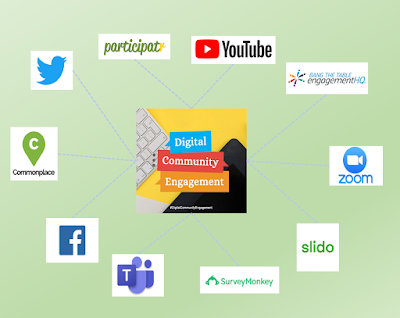Participation, Covid-19 and the ‘Digital explosion’ - are we heading towards a more ‘blended’ approach?
This blog post was written for Grasshopper Communications, and was originally published on their website on the 27th July 2020 (view the original post here).
Our work and home lives have changed significantly over the last few months – across the board, we’ve witnessed an explosion in the use of digital technology. For many of us, this has had a significant impact on the way that we conduct public and stakeholder engagement.
Engagement and participation can mean different things to different people. Here, engagement is considered as a process where individuals, groups, and organisations are actively involved in making decisions that affect them.
This may involve engaging with specific interest groups, and/or the wider public. Extensive and inclusive community and stakeholder engagement are fundamental to project delivery in many key areas of work; including planning, development, implementation, decision-making, research, consultation, information provision, and policy.
Covid-19 and the digital ‘explosion’
Lockdown has resulted in planned and ongoing engagement activities being cancelled, postponed, and/or moved online. While using digital and online tools for engagement is not new, there has certainly been a noticeable increase in the use of these approaches as face-to-face contact has been restricted.
Over lockdown, different groups and organisations have been using a variety of virtual tools such as webinars (e.g. Zoom), online surveys, social media, and virtual exhibitions. The use of specialist online consultation platforms (such as Commonplace, which uses a holistic, inclusive, and innovative map-based approach to online engagement) have become more widely used. Other interactive web-based platforms for place-making and community engagement include EngagementHQ, Participatr and The Future Fox. A multitude of tools are often used (and combined) at different stages of the engagement process, and selected based on their appropriate use for different audiences and/or project outcomes.
There’s been a lively discussion around which tools are available; what works well, what doesn’t work, and areas for future innovation. Grasshopper Communications have reflected on this since lockdown began on their insight blog (also see their digital community engagement group on LinkedIn, which was set up to connect engagement professionals and share resources). A great way to stay up-to-date with digital engagement events and resources is Twitter, by following others and using relevant hashtags.
Engagement during lockdown: what can we learn to inform future practice?
COVID-19 has resulted in a huge shift in the way we use digital communication and offers extensive scope to drive forward change to community engagement around placemaking at a pace not seen before.
My PhD research aims to explore how digital tools help to improve engagement in planning and decision-making processes. By asking important questions about how we can engage with people in the most effective, fair, and inclusive ways possible, we can help keep important conversations going to inform strategies for the future.
My infographic “Considerations for digital engagement” summarises some key themes and important questions we can ask when developing engagement strategies in the future. We need to think about:
Practical considerations for digital engagement; e.g. understanding what’s changed during the lockdown, what barriers exist to uptake, and important concerns such as privacy, security, and GDPR.
Ethical implications of using digital tools, and how this impacts the quality of the engagement process. This includes digital inclusions and exclusions, equality and power relations, and the ease of connecting and engaging with quiet, under-represented, or ‘hard-to-reach’ groups.
Future innovations and exploring whether there’s an optimum ‘blend’ of face-to-face and digital techniques. This includes considering how we can make well-informed choices regarding the most effective and inclusive approaches for different projects and audiences.
The lockdown provides a unique opportunity to understand the value and appropriate use of different digital engagement tools. We can consider people’s responses and attitudes towards different engagement approaches – do those involved (e.g. communities and key stakeholders) feel that engagement is a higher quality when online, or in-person? It’s useful to think about how we use different tools, their impact on the engagement process, and how these choices affect the knowledge produced.
 |
| Click to enlarge |


